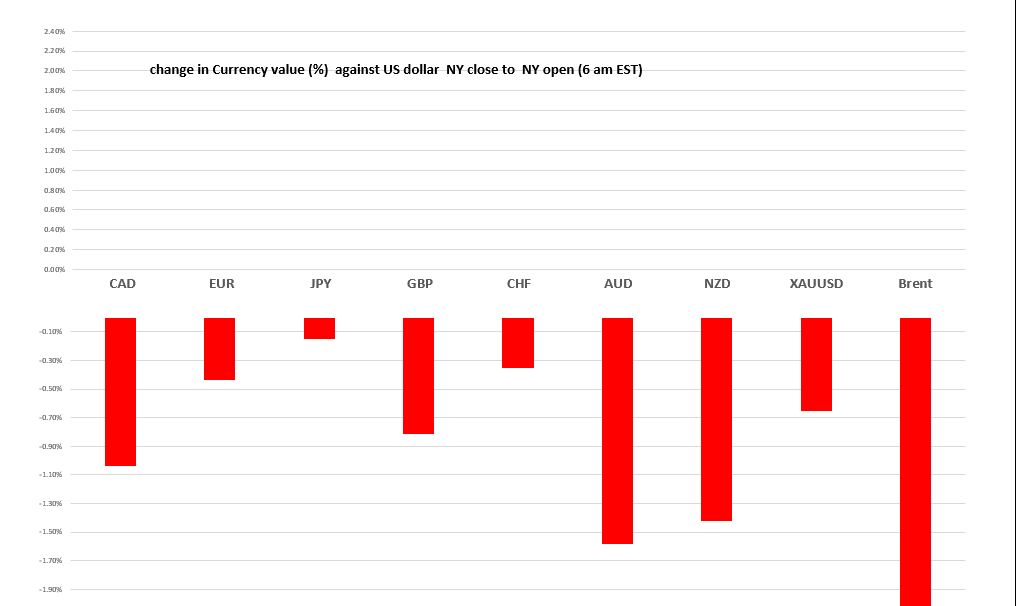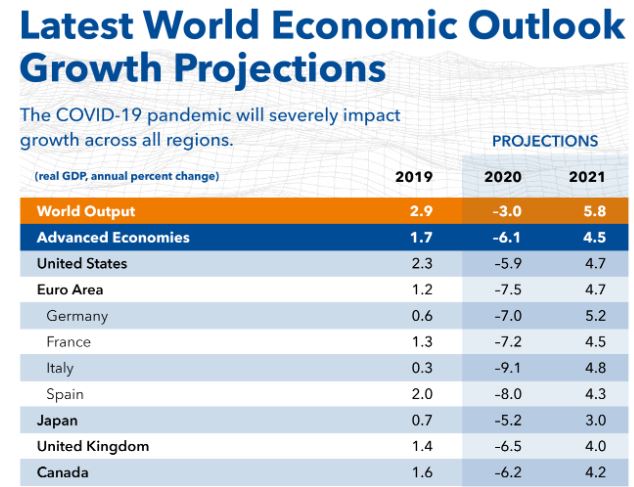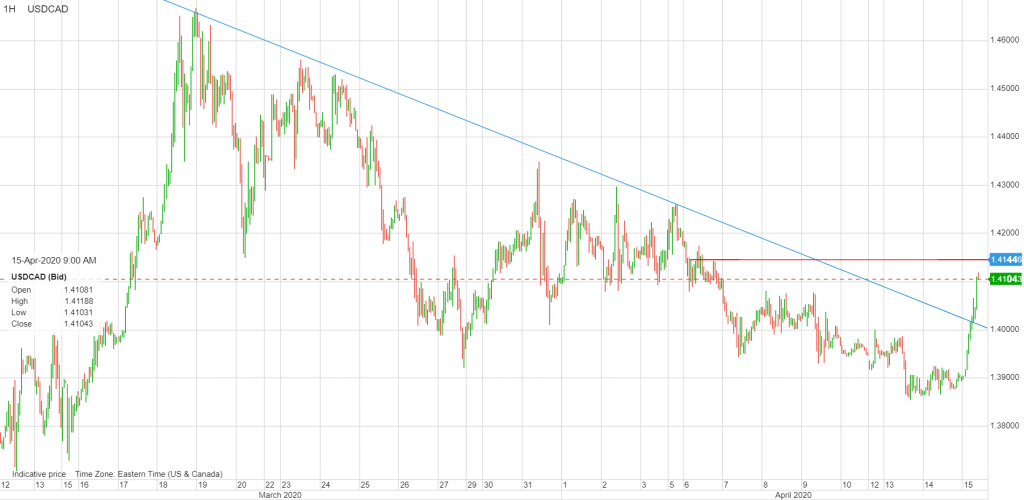
April 15, 2020
USDCAD open (6:00 am EST) 1.4016-20 Overnight Range 1.3879-1.4097
- StatsCanada GDP “NowCast” for March -9.0%
- US Retail Sales and Empire State Manufacturing Index sewer
- IMF downgrades 2020 growth by 6.3% from January. New forecast -0.3% for 2020
- Oceans of oil undermine Opec/Non-Opec crude production cuts
- IEA forecasts global oil demand to drop by 9.3 mb/d in 2020
- US dollar recoups Tuesday’s losses,and adds to them in NY trading
Chart: Currency gain/loss (%) against the US dollar from NY close to NY open (6:00 EST)

Source: Saxo Bank/IFXA
FX Recap and outlook: Statistics Canada wants to be relevant and timely. To that end they introduced a flash estimate of monthly GDP for March but with the qualifier “These estimates should not be expected to have the same quality as Statistics Canada’s official estimates of GDP and should be seen as a tool to inform users of the change in GDP.”
The results were as ugly as one might expect. March GDP declined 9.0%. USDCAD surged on the news, rising from 1.4025 to 1.4108 (as of 6:00 PDT)
US Retail Sales plunged 8.7% m/m in March, and the April Empire State Manufacturing Index dropped to -78.2% from -21.5% previously. The US dollar added to its overnight gains in NY trading, led by a drop in EURUSD. US Treasury yields inched lower and US equity futures extended their overnight losses.
The IMF had a lot to say yesterday, and Asia traders didn’t like what they heard. The Quarterly World Economic outlook downgraded global growth from January’s 6.3% forecast to negative 3.0%.
That prediction assumes the impact from CVOID-19 peaks in Q2 and then recedes for the rest of the year.

Source: IMF
Asia equity markets were reluctant to follow Wall Street’s Tuesday gains with gains of their own. The major indexes closed with small losses. European bourses are down on the day, with the UK FTSE 100 and the German DAX down 1.90%.
EURUSD drifted lower, falling from 1.0991 in Asia to 1.0922 in Europe, before dropping to 1.0905 in early NY trading, on the back of risk aversion following the IMF report. The single currency is suffering from the perception that the EU finance minister reaction to the pandemic was “too little-too late,” which will prolong the economic crisis in the Eurozone. The plunge in crude prices also hurt sentiment.
GBPUSD mirrored EURUSD moves, peaking in Asia at 1.2630 and then probing the bottom at 1.2500 in early NY trading. In addition to the ongoing pandemic concerns and all the baggage that surrounds it, traders are cautious ahead of the start of the EU/UK trade talks tomorrow.
USDJPY traded sideways in Asia and inched higher in Europe, trading in a 106.94-107.50 range. USDJ{PY selling from a drop in 10-year US Treasury yields from 0.768% to 0.679%, and mild safe-haven demand was offset by broad US dollar strength.
AUDUSD and NZDUSD were swamped by US dollar demand stemming from new risk-aversion demand and falling commodity prices. Weaker than expected Australia consumer confidence added to the AUDUSD selling pressure.
Oil prices continued to fall. The weekly API crude stocks report showed US inventories rising 13.1 million barrels, underscoring concerns of a global glut, highlighted by the IEA Oil Market Report. The IEA predicted global oil demand would drop by 9.3 million bpd in 2020. WTI fell to $19.23 from $20.87/barrel.
USDCAD soared on the back of plunging crude prices, and broad US dollar demand due to the pessimistic IMF report. USDCAD opened with a bid today, rising from 1.4020 to 1.4064, as traders reacted to the overnight price action and the shift in the technical picture from bearish USDCAD to bullish.
The Bank of Canada policy meeting and press conference is this morning. The BoC cut rates three times in March and announced a Canadian quantitative easing program which pretty much takes care of any initiatives today.
Instead, markets will focus on Governor Poloz’s press conference, which isn’t likely to be very optimistic.
Today’s US data, which includes Retail Sales and Industrial production, will serve to remind markets of the damage the pandemic has done to the US economy. That reminder may provide more support to the US dollar..
USDCAD technical outlook:
The intraday USDCAD technicals are bullish, following the break above the March 19 downtrend line today which was 1.4010. The move suggests that a short term bottom is in place at 1.3860, and opens the door to further gains to 1.4260. For today, USDCAD support is at 1.3980 and 1.3920. Resistance is at 1.4070 and 1.4150. Today’s Range 1.4010-1.4110
Chart: USDCAD 1 hour

Source: Saxo Bank





